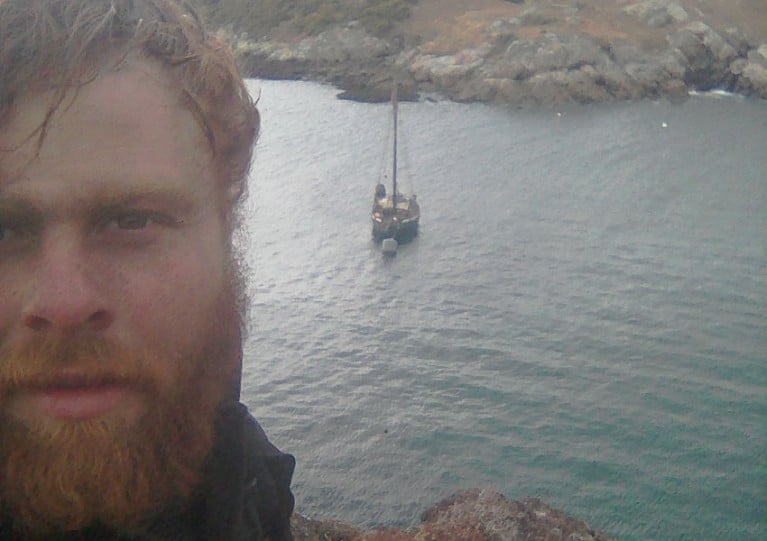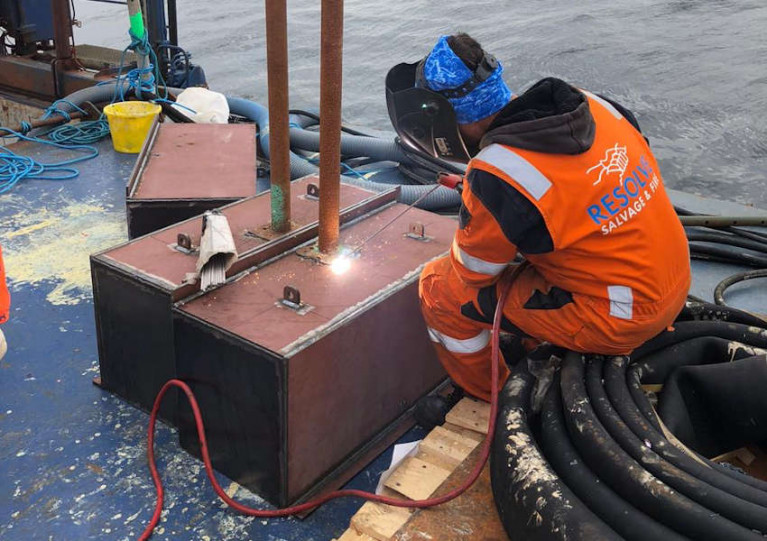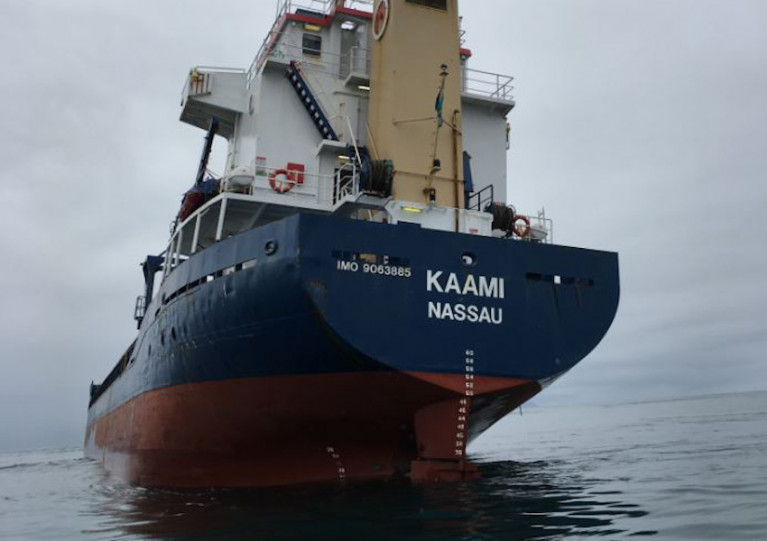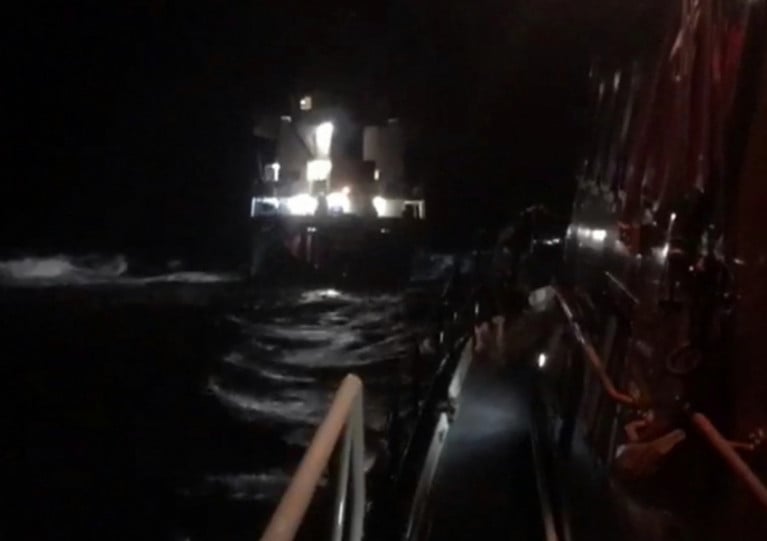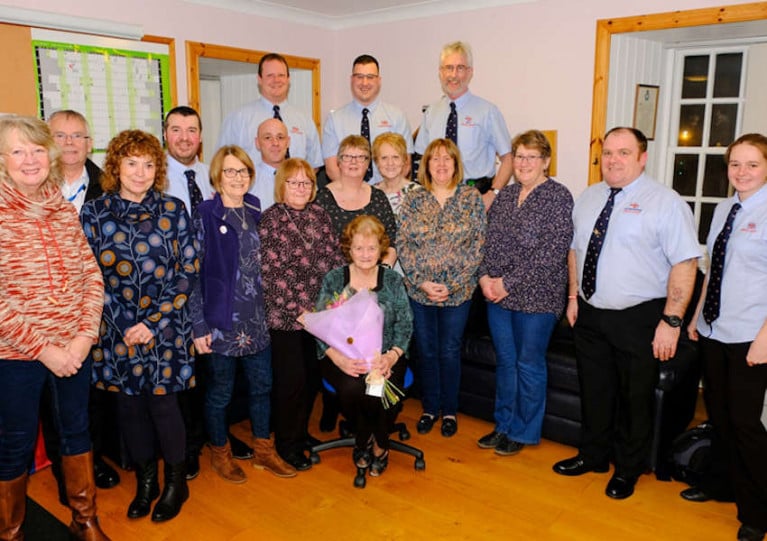Displaying items by tag: Scotland
A modern-day Viking hopes to complete an epic journey by land and sea from Norway to the Midlands despite the setbacks of stormy weather and the coronavirus pandemic.
As RTÉ News reports, Darragh Carroll left the island of Tromoya off Norway’s southeast coast last November in a traditional wooden boat named Rán, for the Norse goddess of the sea.
The chef by trade made it as far as Cape Wrath in the Scottish Highlands when Storm Brendan struck in January, and Run was stranded on the sandy band in Loch Eriboll for two months until the tides were high enough to refloat.
With the boat’s engine flooded, Carroll was forced to rely on wind power alone for the final leg from northern Scotland to the East Coast of Ireland.
But as he neared his home in Dublin, the coronavirus crisis put a roadblock on his plans to bring a flame he’d taken from Norway to the Hill of Uisneach in Co Westmeath.
RTÉ News has more on the story HERE.
Overdue Vessel Sparks Major Search Off Skye
An overdue vessel sparked a major search off Skye in western Scotland last night (Saturday 9 May) involving two RNLI stations, multiple coastguard teams and an SAR helicopter.
The operation began at 8.40pm after a four-metre RIB, reportedly with two people and a dog on board, had failed to return to Strollamus on Skye as expected.
Kyle RNLI’s lifeboat Spirit of Fred Olsen launched within minutes after a report from a concerned member of the public.
The crew began a search of the coastline and small islands from Kyleakin heading north, while volunteers with Portree RNLI did the same heading south.
With light fading fast at 10pm and still no sign of the missing RIB, the Stornoway-based HM Coastguard helicopter was tasted to the scene.
Meanwhile, one of the Kyle lifeboat crew spotted a small light on the normally uninhabited island of Scalpay, which on investigation belonged the two people from the missing RIB.
They explained that they had gone ashore after suffering engine problems with their vessel, and were uninjured by their ordeal. The crew took them back to the Skye mainland at Broadford.
Speaking of the incident, a Kyle RNLI spokesperson said: “The couple had gone out searching for whelks when they had issues with their engine, so went ashore on Scalpay.
“The initial report had said they had a dog with them, however we discovered they had decided to leave it at home on this occasion.
“This search shows that during these unprecedented times of lockdown with bans on non-essential travel, the RNLI is still on call 24 hours a day.”
Salvors successfully offloaded the last recoverable cargo from the grounded MV Kaami in western Scotland last Thursday, 30 April.
As previously reported on Afloat.ie, the MV Kaami ran aground in the Minch between Skye and Lewis on 21 March, just days after leaving Drogheda Port en route for Sweden.
The MV Kaami’s eight Russian crew were rescued within hours of the incident, but the 90m cargo vessel remains at the spot known locally as Eugenie Rock.
Work began last month to remove cargo from the vessel, and divers were able to access the hold to assess any internal damage.
Weather conditions during the early part of last week made it unsafe for the salvors to board the vessel and slowed down the salvage operation.
But more settled weather on Thursday allowed for some 30 tonnes of cargo to be removed and transferred to a landing craft for disposal.
The focus of the salvage operation is now on completing repairs to make the vessel watertight and to allow for it to be refloated.
Work Continues To Remove Cargo From Vessel Aground Off Scotland After Sailing From Drogheda
Work continues at pace to remove cargo from the MV Kaami which ran aground off Skye in western Scotland after sailing from Drogheda Port last month.
A further 22 skips of cargo were removed yesterday (Monday 20 April), meaning a total of 160 skips worth of cargo have now been taken ashore.
Divers have also now been able to access the hold of the vessel to begin internal damage assessment.
The ship remains aground in the Minch between Skye and Lewis.
Stephan Hennig, the Secretary of State’s Representative for Maritime Salvage and Intervention, said: “Thanks to good weather and sea conditions, progress is being made swiftly.
“The removal of so much cargo now means we’re getting closer to the next phase of the salvage which will focus on assessing the internal damage and attempting to temporarily repair damaged sections of the ship.”
As previously reported on Afloat.ie, an exclusion zone had been stablished around the Nassau-registered cargo ship after it ran aground at Eugenie Rock within days of leaving Drogheda Port on 21 March.
The vessel’s eight Russian crew were rescued from the spot some six nautical miles north-west of Duntulm on Skye.
Exclusion Zone Set Up At Cargo Ship Out Of Drogheda That Ran Aground In Western Scotland
An exclusion zone was set up around a cargo ship out of Drogheda that ran aground in Scotland’s Hebrides earlier this week, as it was battered by persisting storm conditions.
As previously reported on Afloat.ie, eight crew were airlifted from the MV Kaami on Monday (23 March) after it grounded on a reef known locally as Eugenie Rock, some six nautical miles off the Isle of Skye.
The MV Kaami had left Drogheda Port less than two days previously, en route for Slite in Sweden, with a cargo of refuse-derives fuel (RDF) in pellet form.
The Press and Journal reports that a salvage team arrived on Tuesday (24 March) to inspect the abandoned vessel, while the tug Ievoli Black remained at the scene on guard.
Eight Crew Airlifted From Cargo Ship Aground Off Skye
Eight crew were rescued from a cargo ship out of Drogheda that ran aground off the Isle of Skye in Scotland’s Inner Hebrides early yesterday morning (Monday 23 March).
The MV Kaami had left Drogheda Port on the evening of Saturday 21 March and was due to arrive in Slite, Sweden this weekend.
But the 90m cargo vessel ran aground in The Minch at what’s known locally as Eugenie Rock, about six nautical miles north-west of Duntulm on Skye.
Portree RNLI’s lifeboat was launched at 2.24am yesterday morning in response to a MayDay call from the MV Kaami, as did the Emergency Towing Vessel Ievoli Black and the Pharos, a Northern Lighthouse Board buoy-laying vessel.
The duty Stornoway Coastguard rescue helicopter arrived on scene, where weather conditions has a Force 8 southerly wind with a rough sea state, and began to airlift eight of the Russian crew to Stornoway. No injuries were reported.
Lerwick Lifeboat Guild Fundraising Volunteer Steps Down After 38 Years
Bella Irvine has retired from the Lerwick Ladies Lifeboat Guild after 38 years service, since first volunteering for the Shetland Islands RNLI unit in 1982.
At a gathering at RNLI Lerwick lifeboat station to mark the occasion last Tuesday evening (4 February), members of the guild and current lifeboat crew members paid tribute to Bella’s contribution on the committee.
After her first 10 years, Bella was then treasurer for 23 years, from 1992 until 2015. Since then, she has continued to support fundraising events and activities, including volunteering in the RNLI Lerwick shop.
In recognition of her long service, Bella received a RNLI Gold Badge and Bar in 2016.
The guild raises funds for the RNLI towards the operational costs of the Lerwick lifeboat in Scotland's far nothern isles, which relies entirely on public donations.
‘She’s one in a million and will always be welcome in our shop, where she will always find the kettle on’
Throughout the year, the guild organises many events, including the popular Lifeboat Open Day in midsummer and the Lifeboat Ball later in the year. Committee members also attend country shows during the summer months to generate income and to raise the profile of the RNLI.
In 2019, the Lerwick Lifeboat Guild, including funds raised by the men’s committee, raised a total of over £44,000.
Rhoda Watt, joint chair of the Lerwick Ladies Lifeboat Guild and current treasurer, said: “Bella has been absolutely dedicated beyond measure and will be missed on our committee. She’s one in a million and will always be welcome in our shop, where she will always find the kettle on.”
Malcolm Craigie, RNLI Lerwick lifeboat operations manager, said: “The RNLI relies on dedicated fundraisers across the country to provide equipment and training for our volunteer crews, so that we’re ready to respond 24 hours a day.
“On behalf of the lifeboat crew, we’re hugely grateful to Bella for everything she has done for the Lerwick Lifeboat Guild over the last 38 years.”
Oban Lifeboat Launches Into Storm Ciara
The volunteer crew of Oban RNLI’s lifeboat Mora Edith MacDonald faced the gale-force conditions of Storm Ciara on two separate callouts yesterday (Sunday 8 February).
At 10:14am, HM Coastguard requested an immediate launch following reports of a group of divers in difficulty to the south of Oban, in Western Scotland.
Despite challenging conditions the lifeboat reached the scene quickly, but found that the divers had already been recovered from the water.
The lifeboats small inflatable XP boat was made ready to put a crew ashore to assist with casualty care. However, the Scottish Ambulance Service and coastguard rescue teams arrived at that point and were able to assist the casualties.
At this time, further reports reached the coastguard of another diver drifting to the north. The lifeboat immediately proceeded to the scene and discovered that the object was actually the dive gear of one of the divers now being treated by the Scottish Ambulance Service.
After the crew returned to station and as they were drying off, one of the volunteers noticed a dingy drifting across Oban Bay.
It was observed that the oars were in place on the dinghy, which prompted concern that someone may have fallen from it, so the crew relaunched into Storm Ciara to ensure that no life was at risk.
Several boats were on moorings in Oban Bay and a systematic search of these moorings began. Oban Coastguard Team, who had also just returned from the previous incident located the dinghy and were able to identify a name on it.
Fortunately this allowed them to locate the owner, who was safe and well and unaware that his dinghy had gone adrift.
Tobermory RNLI’s volunteer crew took part in a multi-agency operation to evacuate an injured man from a local fish farm yesterday morning, Wednesday 5 February.
Following the report of a crush injury at the fish farm in the Sound of Mull, Tobermory RNLI’s volunteer crew launched their Severn class all-weather lifeboat, Elizabeth Fairlie Ramsey, shortly after 10am.
The crew collected two Scottish Ambulance Service personnel and a member of the local coastguard rescue team, and proceeded to the fish farm by MacLean’s Nose on the south coast of Ardnamurchan, near to Kilchoan.
Having stabilised the injured man, the lifeboat returned to Tobermory where the crew were met by other members of the local coastguard team and Police Scotland.
The casualty was transferred to a waiting ambulance before being taken to Tobermory Golf Club for a further transfer to the air ambulance, Helimed 5, which then flew the man to Glasgow for hospital treatment.
Lifeboat operations manager Dr Sam Jones said: “This was another great example of multi-agency working between the emergency services in our local community and beyond.
“We’d like to thank all those at the fish farm who gave immediate first aid on scene and all of us at the station wish the injured man a very speedy recovery.”
This was also the first shout for one of Tobermory RNLI’s newest recruits, Jenny Hampson, a project manager for the Tobermory Harbour Association.
Tobermory Lifeboat’s ‘Kiwi’ Is New World Mince & Tatties Champion
Tobermory RNLI’s deputy second mechanic Tony ‘Kiwi’ Spillane has been announced as World Mince and Tatties Champion for 2020.
After the All Blacks' disappointing run in the Rugby World Cup last year, the New Zealander made his home country proud by emerging victorious in the contest at the Mishnish in Tobermory yesterday, Saturday 25 January.
‘Kiwi’ has continued in a tradition of world champions at the lifeboat station, on the Isle of Mull in western Scotland, with operations manager Dr Sam Jones winning the title in 2007 and former coxswain Phil Higson being champion in 2008 and 2011.
Competitors submit their best plate of mince and tatties to a panel of judges, with the winner being declared world champion.
But there was controversy when it emerged that coxswain David McHaffie and Dr Sam Jones had been two of the three judges, and some of the audience claimed that there had been ‘a fix’.
But Dr Jones dismissed the accusations. “Kiwi won his world title absolutely fair and square,” he said. “It was a blind tasting and none of us had any idea whose mince we were sampling.
“We’re hoping that at our next training night, Kiwi will cook up his championship dish to warm up the volunteer crew when they come back from exercise.”



























